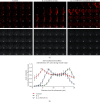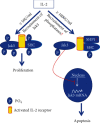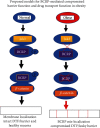Mucosal Epithelial Jak Kinases in Health and Diseases
- PMID: 33814980
- PMCID: PMC7990561
- DOI: 10.1155/2021/6618924
Mucosal Epithelial Jak Kinases in Health and Diseases
Abstract
Janus kinases (Jaks) are a family of nonreceptor tyrosine kinase that include four different members, viz., Jak1, Jak2, Jak3, and Tyk2. Jaks play critical roles in immune cells functions; however, recent studies suggest they also play essential roles in nonimmune cell physiology. This review highlights the significance of epithelial Jaks in understanding the molecular basis of some of the diseases through regulation of epithelial-mesenchymal transition, cell survival, cell growth, development, and differentiation. Growth factors and cytokines produced by the cells of hematopoietic origin use Jak kinases for signal transduction in both immune and nonimmune cells. Among Jaks, Jak3 is widely expressed in both immune cells and in intestinal epithelial cells (IECs) of both humans and mice. Mutations that abrogate Jak3 functions cause an autosomal severe combined immunodeficiency disease (SCID) while activating Jak3 mutations lead to the development of hematologic and epithelial cancers. A selective Jak3 inhibitor CP-690550 (Xeljanz) approved by the FDA for certain chronic inflammatory conditions demonstrates immunosuppressive activity in rheumatoid arthritis, psoriasis, and organ transplant rejection. Here, we also focus on the consequences of Jak3-directed drugs on adverse effects in light of recent discoveries in mucosal epithelial functions of Jak3 with some information on other Jaks. Lastly, we brief on structural implications of Jak3 domains beyond the immune cells. As information about the roles of Jak3 in gastrointestinal functions and associated diseases are only just emerging, in the review, we summarize its implications in gastrointestinal wound repair, inflammatory bowel disease, obesity-associated metabolic syndrome, and epithelial cancers. Lastly, we shed lights on identifying potential novel targets in developing therapeutic interventions of diseases associated with dysfunctional IEC.
Copyright © 2021 Narendra Kumar et al.
Conflict of interest statement
The authors declare that they have no conflicts of interest with the contents of this article. The content is solely the responsibility of the authors and does not necessarily represent the official views of the National Institutes of Health.
Figures









Similar articles
-
Janus kinases in immune cell signaling.Immunol Rev. 2009 Mar;228(1):273-87. doi: 10.1111/j.1600-065X.2008.00754.x. Immunol Rev. 2009. PMID: 19290934 Free PMC article. Review.
-
JAKs in pathology: role of Janus kinases in hematopoietic malignancies and immunodeficiencies.Semin Cell Dev Biol. 2008 Aug;19(4):385-93. doi: 10.1016/j.semcdb.2008.07.002. Epub 2008 Jul 17. Semin Cell Dev Biol. 2008. PMID: 18682296 Review.
-
Development of JAK inhibitors for the treatment of immune-mediated diseases: kinase-targeted inhibitors and pseudokinase-targeted inhibitors.Arch Pharm Res. 2020 Nov;43(11):1173-1186. doi: 10.1007/s12272-020-01282-7. Epub 2020 Nov 8. Arch Pharm Res. 2020. PMID: 33161563 Review.
-
Therapeutic targeting of Janus kinases.Immunol Rev. 2008 Jun;223:132-42. doi: 10.1111/j.1600-065X.2008.00644.x. Immunol Rev. 2008. PMID: 18613833 Free PMC article. Review.
-
The Janus kinases (Jaks).Genome Biol. 2004;5(12):253. doi: 10.1186/gb-2004-5-12-253. Epub 2004 Nov 30. Genome Biol. 2004. PMID: 15575979 Free PMC article. Review.
Cited by
-
Inhibition of T-cell activity in alopecia areata: recent developments and new directions.Front Immunol. 2023 Nov 6;14:1243556. doi: 10.3389/fimmu.2023.1243556. eCollection 2023. Front Immunol. 2023. PMID: 38022501 Free PMC article. Review.
-
JAK2-Mediated Phosphorylation of Stress-Induced Phosphoprotein-1 (STIP1) in Human Cells.Int J Mol Sci. 2022 Feb 22;23(5):2420. doi: 10.3390/ijms23052420. Int J Mol Sci. 2022. PMID: 35269562 Free PMC article.
-
Balancing the Scales: The Dual Role of Interleukins in Bone Metastatic Microenvironments.Int J Mol Sci. 2024 Jul 26;25(15):8163. doi: 10.3390/ijms25158163. Int J Mol Sci. 2024. PMID: 39125732 Free PMC article. Review.
-
Effect of Janus Kinase 3 Inhibitor on Sebaceous Gland Regeneration during Skin Wound Healing.Ann Dermatol. 2023 Aug;35(4):275-284. doi: 10.5021/ad.22.204. Ann Dermatol. 2023. PMID: 37550228 Free PMC article.
-
Brain-Gut and Microbiota-Gut-Brain Communication in Type-2 Diabetes Linked Alzheimer's Disease.Nutrients. 2024 Aug 3;16(15):2558. doi: 10.3390/nu16152558. Nutrients. 2024. PMID: 39125436 Free PMC article. Review.
References
-
- Candotti F., Oakes S. A., Johnston J. A., Notarangelo L. D., O'Shea J. J., Blaese R. M. In vitro correction of JAK3-deficient severe combined immunodeficiency by retroviral-mediated gene transduction. The Journal of Experimental Medicine. 1996;183(6):2687–2692. doi: 10.1084/jem.183.6.2687. - DOI - PMC - PubMed
-
- Safford M. G., Levenstein M., Tsifrina E., et al. JAK3: expression and mapping to chromosome 19p12-13.1. Experimental Hematology. 1997;25(5):374–386. - PubMed
Publication types
MeSH terms
Substances
LinkOut - more resources
Full Text Sources
Other Literature Sources
Research Materials
Miscellaneous

